2. South Asia
The South Asian region has enormous economic potential, particularly in India—the world’s largest democracy, and has been increasing its presence in the international community. South Asia is strategically important to Japan because of its location on a land route and sea lane that connects East Asia with the Middle East, and is also crucial for addressing global environmental issues. In addition, the region is of great interest to Japan and the rest of the international community in regard to the role it plays in international efforts against terrorism and extremism.
At the same time, the South Asian region still faces many issues that must be addressed. These issues include a lack of basic infrastructure such as roads, railroads, and ports, as well as growing populations, low school enrollment ratios in primary education, underdeveloped water and sanitation facilities, inadequate healthcare and medical systems, insufficient maternal and pediatric healthcare, a lack of countermeasures against infectious diseases, and unconsolidated rule of law. Poverty reduction is a particularly challenging problem. Approximately 500 million people among the total regional population of more than 1.6 billion are said to be living in poverty, making it one of the world’s poorest regions.(Note 7) South Asia is the second most important region, behind Africa, in achieving the SDGs.
Japan provides assistance with a focus on improving socio-economic infrastructure in order to harness the economic potential of South Asia as well as to alleviate the growing gap between the rich and the poor.
< Japan’s Efforts >
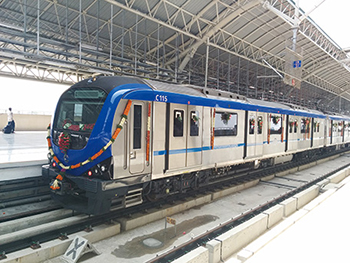
A train car built through the Chennai Metro Project, India. The photo was taken on the day of opening of services, so the train is decorated with flowers, etc. (Photo: Hiroshi Yoshida / JICA)
With India, a key player in South Asia, Japan promotes cooperation in a wide range of fields based on the “Special Strategic and Global Partnership.” These include economic cooperation on projects such as the Western Dedicated Freight Corridor (DFC), which is the backbone of the Delhi-Mumbai Industrial Corridor (DMIC) Projects as well as cooperation in the fields of politics and security, economy, and academic exchanges. India has been the largest recipient of Japan’s ODA Loans in recent years. Japan has provided assistance to India for its development of economic infrastructure, mainly in the field of power and transport. At the Japan-India Summit Meeting during Prime Minister Narendra Modi’s visit to Japan in September 2014, Japan expressed its intention to realize ¥3.5 trillion of public and private investment and financing, including ODA, to India over five years. This would be implemented in concert with India’s efforts to further improve the business environment. These efforts are aimed at realizing the two countries’ common goal of doubling Japan’s direct investment in India and the number of Japanese companies in India within five years. Further, Japan engages in social sector development cooperation aimed at poverty reduction in India, such as rural development.
In December 2015, Prime Minister Abe visited India, and he and Prime Minister Modi confirmed that Japan’s Shinkansen (bullet train) system would be introduced to the high-speed railway between Mumbai and Ahmedabad. In addition, Prime Minister Abe expressed his expectation that the total commitment of ODA Loans to India in FY2015 might reach around ¥400 billion, the highest ever provided to India. It is expected that these elements would contribute to further deepening cooperative economic relations between Japan and India.
With Bangladesh, where there has been remarkable growth and where an increasing number of Japanese companies have been conducting business in recent years, the “Comprehensive Partnership” was launched in May 2014 in the course of a series of mutual visits by dignitaries in that same year, namely, Minister for Foreign Affairs Kishida’s visit to Bangladesh in March, Prime Minister Sheikh Hasina’s visit to Japan in May, and Prime Minister Abe’s visit to Bangladesh in September. In May, Japan announced its commitment to provide up to ¥600 billion of assistance to Bangladesh in approximately four or five years from 2014. In order to deepen the bilateral relations, Japan is strengthening policy dialogue and promoting economic cooperation under the Bay of Bengal Industrial Growth Belt (BIG-B) initiative, whose three pillars are: (i) Developing economic infrastructure in Bangladesh; (ii) Improving investment environment; and (iii) Fostering connectivity.
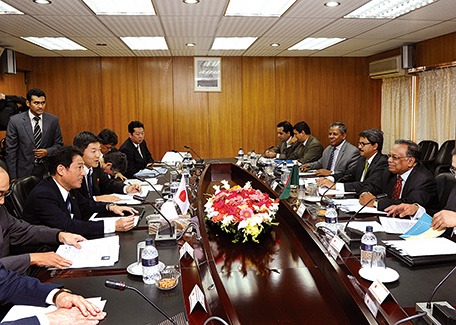
Foreign Minister Fumio Kishida attends the Japan-Bangladesh Foreign Ministers' Meeting in March 2014.
Following Prime Minister Abe’s first visit to Sri Lanka as incumbent Prime Minister of Japan in 24 years in September 2014, Japan and Sri Lanka have continued to deepen and expand cooperative relations in a range of areas after the new administration was inaugurated in January 2015. In October 2015, Prime Minister Ranil Wickremesinghe visited Japan, and the two leaders issued the Joint Declaration on Comprehensive Partnership. This Joint Declaration outlined three initiatives pertaining to: (i) Promotion of investment and trade; (ii) Cooperation on the National Development Plan; and (iii) National reconciliation and peacebuilding. The Joint Declaration expressed a commitment to promoting maritime cooperation as well as human resources development and people-to-people exchange. Japan continues to extend cooperation in the field of development of infrastructure, including transportation and power infrastructure, to contribute to further economic development in Sri Lanka as well as to improvements in the business environment for Japanese companies operating in the country. Considering the history of internal conflict and the development status of Sri Lanka, Japan continues to extend cooperation useful for national reconciliation and provide assistance to cope with natural disasters, including livelihood improvement and industrial development with a focus on the agricultural sector in least developing regions.
Pakistan plays a vital role in the international community’s initiatives to eradicate terrorism, and Pakistan’s cooperation is critically important for the stability of Afghanistan. Japan has thus far implemented $1 billion of assistance pledged at the Pakistan Donors Conference in Tokyo co-hosted by the World Bank in April 2009. Furthermore, Japan has extended support for improving the security capabilities of airports and ports, as well as support for persons who have been internally displaced by military operations to eliminate terrorists. The Sharif administration that was established in June 2013 is putting efforts into improving security, and is working on rebuilding its economy and public finance under the new IMF program approved in September 2013 (three years, $6.64 billion). In order to back up Pakistan’s reform efforts, Japan also provided ¥5 billion for the Energy Sector Reform Program Loan in June 2014. Through such initiatives, Japan supports the development of socio-economic infrastructure, including electric power, and human security components in Pakistan.
As regards Nepal, where efforts to consolidate and develop its democracy are under way via a process of establishing a new constitution, Minister for Foreign Affairs Fumio Kishida held talks with Minister for Foreign Affairs Mahendra Bahadur Pandey, who visited Japan in October 2014 and March 2015. Foreign Minister Kishida announced that Japan would offer continuous assistance for Nepal’s democratization efforts, and further expand and strengthen cooperation on an array of fields including policies. In recent years, bilateral relations have been rapidly deepened, as exemplified by the holding of the first Japan-Nepal political dialogue between the Ministries of Foreign Affairs in March 2015. In response to the massive earthquake that struck Nepal in April 2015, Japan dispatched Japan Disaster Relief (JDR) Teams, and provided Emergency Relief Goods and Emergency Grant Aid amounting to $14 million (¥1.68 billion). In addition, Japan announced an assistance package at a scale totaling $260 million (over ¥32 billion) that focuses on rebuilding houses, schools, and public infrastructure. Japan is extending all possible assistance to help rebuild a resilient Nepal, applying the “Build Back Better” concept formulated at the UN World Conference on Disaster Risk Reduction in Sendai to Nepal’s medium- to long-term reconstruction process.
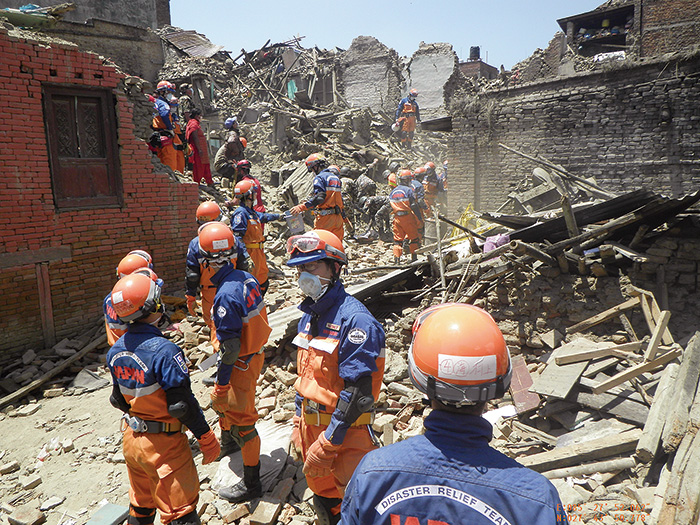
Activities of a Japan Disaster Relief (JDR) rescue team in Nepal. (Photo: JICA)
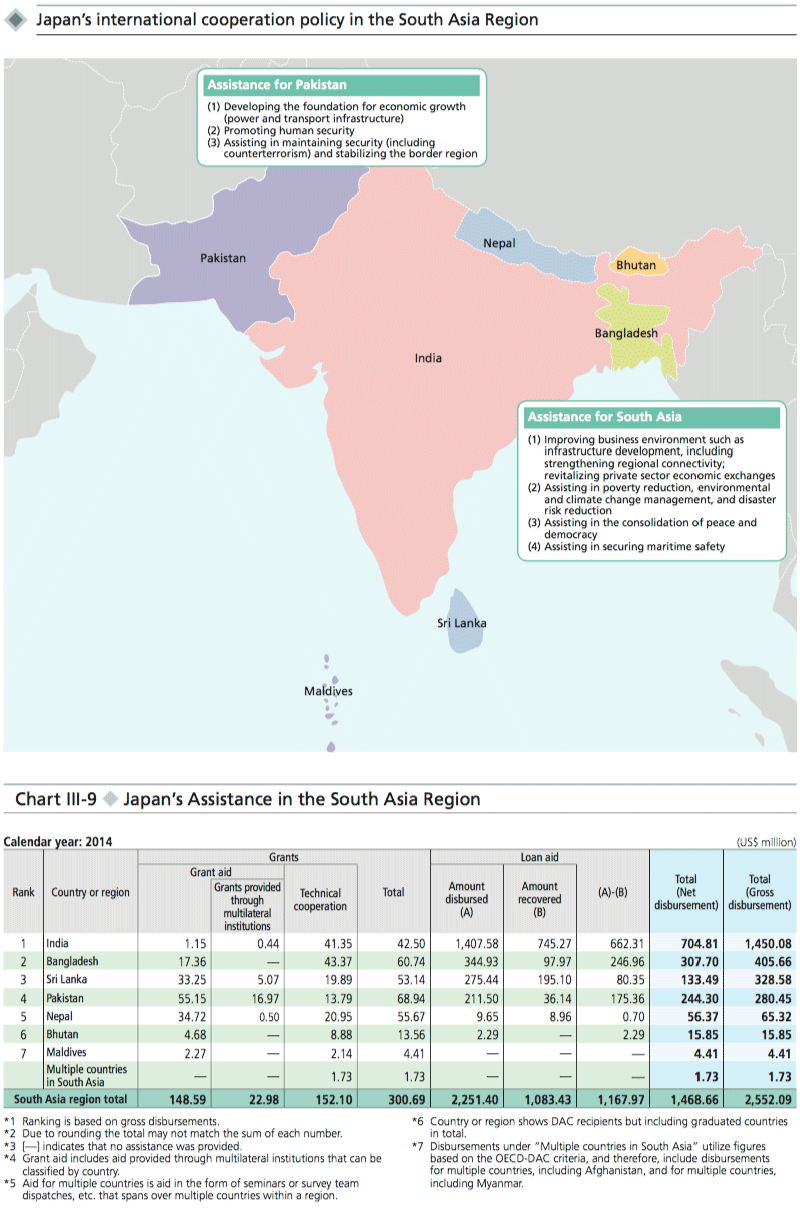
- Note 7: According to “The Millennium Development Goals Report 2015,” the proportion of people living on less than $1.25 a day is 17% (2015). This is the second highest number after Sub-Saharan Africa.
India
Tamil Nadu State Investment Promotion Program
Loan Aid (May 2012 – Ongoing)
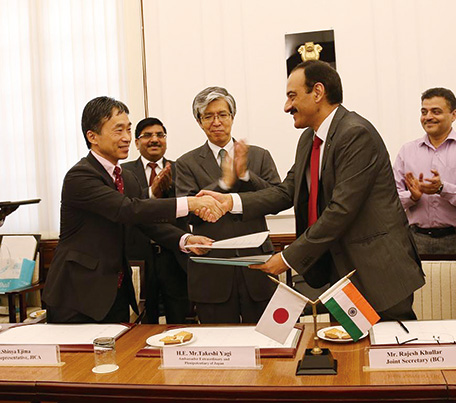
Mr. Rajesh Khullar, Joint Secretary, Department of Economic Affairs, Ministry of Finance of India (right) and Mr. Shinya Ejima, Chief Representative of JICA India Office, shake hands after the signing ceremony. (Photo: JICA)
Tamil Nadu State in Southern India now has a population of over 70 million and its container port is known as the gateway to Southern India. The state capital is Chennai, a city that is famous for having a high concentration of automotive and IT industries. In addition, Tamil Nadu State has a large number of companies in the biochemistry, heavy industry, financial services, and apparel manufacturing fields. For this reason, the state is also a hub for foreign companies and foreign direct investment.
However, investors from Japan and other countries have suffered from undeveloped infrastructure, such as roads, power grids, and water and sewerage systems, and have requested the state to develop infrastructure. In order to create a favorable investment environment and attract the foreign direct investment needed for economic growth, Tamil Nadu State needs to improve both its infrastructure and systems.
The Government of India announced a long-term strategy called “Vision Tamil Nadu 2023” in March 2012. Under this strategy, India initiated efforts to improve the investment environment, including the development of infrastructure. The Government of Japan started to assist India in the form of a development policy loan*1. This was the first case for India to receive a loan from Japan in this form.
This ODA loan will not be used to fund a specific infrastructure project. Instead, the loan will be executed in phases based on the progress made by Tamil Nadu State Government towards achieving various policy goals each fiscal year. Specifically, these goals are as follows. First, Tamil Nadu State Government will improve policies, systems, and procedures for the development of a favorable investment environment. This includes improving the investment application process, changing the land acquisition system, and encouraging the development of industrial human resources. Second, Tamil Nadu State Government will develop road, power, and water and sewerage infrastructure. In other words, the aim of this loan is to improve infrastructure, and to improve policies and systems as a whole for encouraging investment at the same time.
While India’s GDP growth rate is a robust 7.3% (FY 2014), per capita GDP remains low at only $1,596 (FY 2014). There are therefore high hopes that India will be able to further boost GDP by developing its cutting-edge business and industry.
Tamil Nadu State is home to a variety of industries. Japan believes that developing the State’s business environment and infrastructure will contribute to improving the lives of the Indian people, by fostering its economic development and creating more sophisticated industries. (As of August 2015)
*1: A loan intended to assist the policy and system reform efforts of developing countries. The central portion of the loan is disbursed after it is confirmed that the government of the partner country has achieved certain reform goals that were agreed upon in advance.
Pakistan
The Project for Promotion of Value Added Fruit Products in Gilgit-Baltistan
Technical Cooperation Project (August 2012 – Ongoing)
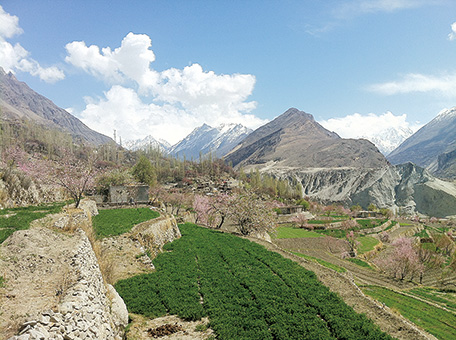
Apricot trees in the Hunza district, the setting of the film“Sougen no Isu (A Chair on the Plains)” based on a novel by Teru Miyamoto. (Photo: JICA)
Gilgit-Baltistan in Northern Pakistan is known as “the last Paradise,” and is surrounded by the majestic peaks of the Karakoram Mountains. The region is fantastically beautiful in spring, when it is blanketed in the white and pink flowers of apricot trees. The cool climate makes the region ideal for fruit orchards.
However, the people who live here strongly believed that fruit grows on its own. They never sold surplus fruit (37% of the apricot crop and 22% of the apple crop was thrown out in 2012). Given the difficulty of accessing urban areas, people never considered “selling” the fruit that they picked. This meant that their incomes did not improve either.
A policy to encourage and develop high value-added agriculture in this region, as a means to counteract poverty was decided on. The Government of Japan received a request for assistance to develop novel agricultural approaches in Gilgit-Baltistan.
Japan dispatched experts to the region in 2012. These experts traveled together with local farmers to markets in the capital of Islamabad. There they learned that apples from Gilgit-Baltistan are difficult to sell, because they appear unsightly and arrive in different shapes and sizes. This motivated the farmers to learn Japan’s agricultural techniques.
Pilot farmers traveled to Japan to receive training at apple farms in Nagano and Aomori prefectures. There they learned about caring for seedlings, making liquid fertilizers, and harvesting techniques. They also learned processing techniques for producing delicious dried apricots.
These organically-grown dried apricots were exhibited at Japan’s largest import food trade fair. They were very highly appraised. Today, these dried apricots are a popular luxury product sold in Japan’s luxury department stores. In this manner, Japan’s agricultural technologies are helping to improve famers’ incomes in faraway Gilgit-Baltistan. (As of August 2015)
